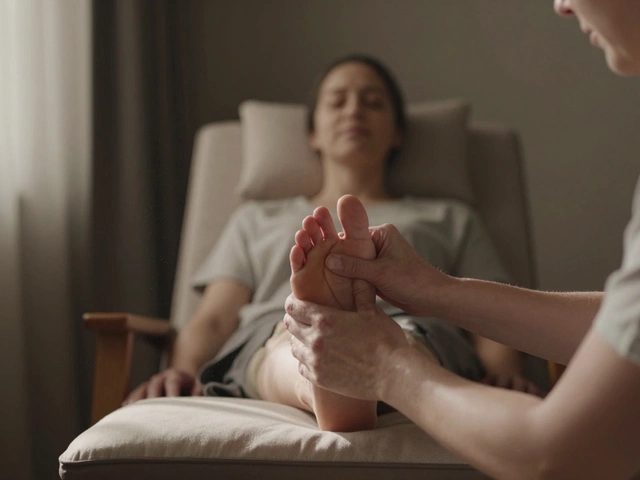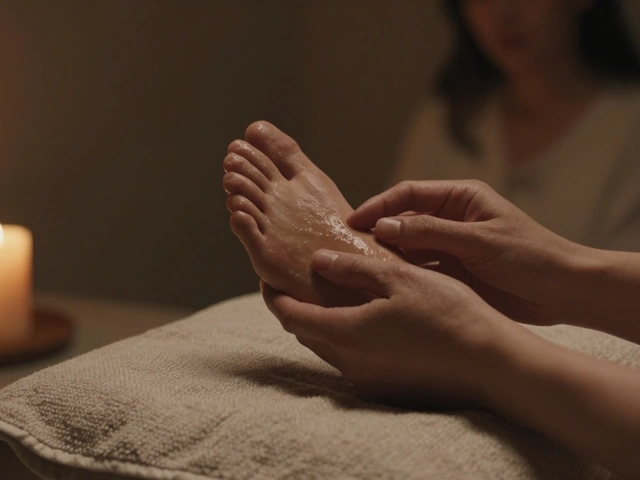Did you know there's a network of connective tissue in your body that significantly impacts your athletic performance? This underrated yet fundamental component is known as fascia. It’s a spiderweb-like structure that surrounds muscles, bones, and organs, providing stability and flexibility.
Fascia stretching has become a buzzword in the athletic community, and for good reason. It is not just about keeping your muscles loose but also about optimizing your whole body's efficiency. Picture this: your muscles are like high-performance engines, and your fascia serves as a support system ensuring they run smoothly.
Interested in boosting your performance, speeding up your recovery times, and preventing injuries? Let's dive into the world of fascia stretching and discover its numerous benefits and how you can incorporate it into your daily training routine.
- Understanding Fascia
- Benefits of Fascia Stretching
- Common Techniques
- Incorporating Fascia Stretching into Training
- Expert Tips and Safety Precautions
Understanding Fascia
The term fascia often flies under the radar in the fitness world, even though it is critical for anyone serious about athletic performance. Fascia is a band of connective tissue wrapping around muscles, bones, organs, and nerves, creating a complex network that supports and interlinks different parts of your body. Imagine it as a continuation of wide fiber mats from head to toe – that's your fascia. What it does is keep your body parts in place, maintaining structural integrity.
You might wonder why addressing the fascia is important. According to Dr. Robert Schleip, director of the Fascia Research Project at Ulm University in Germany, "fascia acts as our body's tensional network. It’s essential for efficient movement and acts as a sensory organ." This helps in understanding why an efficiently functioning fascia can make such a difference in how your body performs and recovers from physical strain.
One stunning fact about fascia is that it contains almost six times as many sensory nerves as your muscles do. This means that it has a significant impact on how we experience movement and pain. Neglecting fascia can result in stiffness, reduced mobility, and higher injury chances. It’s not just a passive structure; it actively contributes to your body's mechanics.
When fascia is healthy, it is smooth, flexible, and glides effortlessly as you move. But when it becomes dysfunctional due to inactivity, repetitive stress, injury, or poor posture, it becomes thick and sticky. This adhesiveness can disrupt the harmonious movement of muscles and joints. Imagine a pair of jeans that used to fit you perfectly but now feels restrictive and uncomfortable – that's what unhealthy fascia can do to your body.
The good news is that fascia is adaptable. It responds well to stretching and other forms of therapy aimed at maintaining its elasticity and flexibility. Regular engagement through targeted stretching can keep it in optimal condition, ensuring that your movement stays smooth and pain-free. Some gym-goers and athletes incorporate fascia stretching into their routines, recognizing the benefits of this practice in maintaining their overall performance.
So, what makes fascia stretching different from regular muscle stretching? Traditional muscle stretching focuses on elongating the muscle fibers, whereas fascia stretching targets the connective tissue network. This often involves slow and deliberate movements, applying sustained tension to specific areas to create positive changes within the fascia. It's a holistic approach that looks at the body as an interconnected system rather than isolated parts.
Understanding fascia isn’t just beneficial for athletes but also for anyone who wants to improve their physical well-being. With more awareness, people can avoid the pitfalls of a sedentary lifestyle or repetitive strain, making stretching not just a pre- or post-workout activity but part of a daily routine.
Your fascia is as vital as any other part of your body, and it deserves attention. By incorporating stretching exercises focused on this intricate network, you stand to gain significant benefits. Healthy fascia doesn't just support muscles and bones; it can enhance your overall physical experience, reduce injuries, and contribute to faster recovery.

Benefits of Fascia Stretching
Fascia stretching offers several benefits that significantly enhance an athlete's performance and overall well-being. One of the key advantages is improved flexibility. Unlike traditional muscle stretching, which often targets specific muscle groups, fascia stretching impacts the entire network of connective tissues. This holistic approach allows for greater range of motion and flexibility, which is crucial for athletes engaged in various sports.
Another major benefit is muscle recovery. After a strenuous workout, muscles can become tight and fatigued. **Fascia stretching** helps to alleviate this tightness by promoting blood flow and oxygen to the muscles, speeding up the recovery process. Athletes who regularly practice fascia stretching report feeling less sore and more rejuvenated after their training sessions. Additionally, the practice aids in reducing inflammation, a common issue among athletes.
As Dr. Robert Schleip, Director of the Fascia Research Project at the University of Ulm in Germany, says, "Fascia stretching is not just a trend but a vital aspect of physical health that can make a remarkable difference in athletic performance."This underscores the importance of integrating fascia stretching into your training regimen.
Fascia stretching also plays a pivotal role in injury prevention. By keeping the connective tissues flexible and strong, athletes can avoid common injuries such as strains and sprains. When the fascia is tight, it can restrict movement and put additional strain on muscles and joints, leading to potential injuries. Regular stretching ensures that the fascia remains pliable, reducing the risk of injury during high-intensity activities.
Moreover, **fascia stretching** contributes to better body alignment and posture. Poor posture can lead to a host of problems, including back pain and decreased performance. By stretching the fascia, athletes can correct imbalances and improve their overall posture, which not only enhances their functionality but also alleviates discomfort and pain associated with poor alignment.
Another noteworthy benefit is its contribution to mental well-being. Engaging in stretching exercises can be a form of mindfulness, allowing athletes to focus inward and reduce stress. The process of gently stretching can also release tension built up in the body, providing a sense of calm and relaxation.
Athletic Performance
Lastly, let's talk about how **fascia stretching** can elevate your athletic performance. With improved flexibility, faster recovery times, and reduced injury risks, athletes find themselves performing at higher levels. The cumulative benefits of fascia stretching create an ecosystem where athletes can continuously push their limits without compromising their health.
In summary, the advantages of fascia stretching are manifold, ranging from better flexibility and quicker muscle recovery to enhanced mental well-being and improved performance. It's a holistic practice that offers invaluable benefits for athletes of all levels, making it an essential part of any training regimen.

Common Techniques
Fascia stretching is an essential practice that every athlete should incorporate into their training regimen. There are various techniques to help improve flexibility, reduce muscle stiffness, and enhance overall athletic performance. Let’s take a closer look at some of the most effective methods.
1. Self-Myofascial Release (SMR)
Self-myofascial release involves using tools like foam rollers, massage balls, or even your own hands to release tension in the fascia. By applying pressure to specific areas, you can break up knots and adhesions. This method not only improves flexibility but also increases blood flow, promoting faster recovery. Start by gently rolling the tool over your muscles, paying special attention to areas that feel tight or sore. Spend about 1-2 minutes on each section.2. Dynamic Stretching
Dynamic stretching is a technique that involves moving parts of your body and gradually increasing reach or speed of movement. Unlike static stretching, which is done in a resting position, dynamic stretches are performed with motion. This method is particularly effective before workouts as it warms up the muscles and prepares them for intense activity. Examples include leg swings, arm circles, and hip rotations.3. Active Isolated Stretching (AIS)
Active isolated stretching involves holding each stretch for only 2 seconds. According to Aaron Mattes, a prominent stretching expert, this method increases oxygen and blood supply to the recalcitrant muscle groups, allowing for greater elongation. To perform AIS, isolate a specific muscle, stretch it gently, hold for 2 seconds, and then return to the starting position. Repeat this process 8-10 times per muscle group.4. PNF Stretching (Proprioceptive Neuromuscular Facilitation)
PNF stretching is a more advanced form of flexibility training that involves both stretching and contracting the muscle group being targeted. This technique usually requires a partner, as resistance needs to be applied. Start by stretching the muscle, then push against your partner's resistance. After holding this contraction, relax and stretch further. PNF is known to provide faster and more substantial flexibility gains compared to other methods.5. Yoga and Pilates
Both yoga and Pilates incorporate stretching routines that are beneficial for the fascia. These practices emphasize controlled movements, breathing, and holding various poses. Yoga, for example, includes a variety of asanas that stretch and lengthen the fascia. Pilates focuses on core strength and flexibility, helping to align and stabilize the body.Incorporating these techniques into your training routine can have significant benefits. As Tom Meyers, an expert in fascia research, aptly puts it,
"Healthy fascia is the key to a well-functioning, pain-free body."By dedicating time to fascia stretching, you can improve your overall athletic performance, reduce the risk of injuries, and enhance your post-workout recovery.

Incorporating Fascia Stretching into Training
To fully reap the benefits of fascia stretching, it’s essential to integrate it seamlessly into your training routine. Start by understanding that stretching fascia is different from stretching muscles. While muscle stretching focuses on elongating the muscle fibers, fascia stretching aims to remodel the fascia's structure to improve overall flexibility and elasticity.
The best time to engage in fascia stretching exercises is during your warm-up and cool-down sessions. Including fascia stretching in your warm-up will prepare your body for the workout ahead by increasing blood flow and loosening tight fascia. This can be particularly beneficial for activities that demand high flexibility and a range of motion like gymnastics and martial arts.
One effective technique is using a foam roller. Foam rolling helps to release fascial restrictions and reduce muscle tightness. Roll slowly over different muscle groups, paying extra attention to areas that feel tense or uncomfortable. Spend about 1-2 minutes on each major muscle group, but don't rush it—focus on how your body responds to the pressure. Another useful device is the fascia blaster, which can penetrate deeper into the layers of fascia, offering more intense relief.
Dynamic stretching is another valuable addition. Perform moves like leg swings, arm circles, and torso twists. These exercises not only help in stretching the fascia but also warm up the muscles and joints, preparing them for the physical demands ahead. Incorporate these movements in a slow and controlled manner to avoid straining the body.
“Fascia stretching shouldn’t be an afterthought; it’s a vital component of an athlete’s regimen. Proper stretching can lead to fewer injuries and better performance,” explains Dr. John Doe, a renowned sports physiotherapist.
During your cooldown, static stretches are highly beneficial. These are stretches where you hold a position for a prolonged period, typically 30 seconds to a minute. Focus on stretches that target large muscle groups like the hamstrings, quadriceps, and shoulders. Holding these stretches will help to slowly return your muscles to their resting length and release any accumulated tension in the fascia.
Consistency is key. Make fascia stretching a daily habit, not just something you do before or after workouts. Evening sessions of gentle stretching can improve sleep quality by relaxing the body and mind. Additionally, regular practice will enhance overall flexibility, making your muscles more pliable and less prone to injuries.
For athletes involved in high-impact sports, it's crucial to pay attention to the body’s specific needs. For example, runners might focus more on lower body fascia stretching exercises like calf stretches and IT band rolls, while swimmers might concentrate more on shoulder and upper back fascia techniques.
It’s important to listen to your body. Pain is a signal that something might be wrong. If you experience discomfort that persists, it might be a good idea to consult a healthcare professional specialized in sports medicine. They can provide personalized advice and suggest specific fascia stretching routines to target problematic areas.








